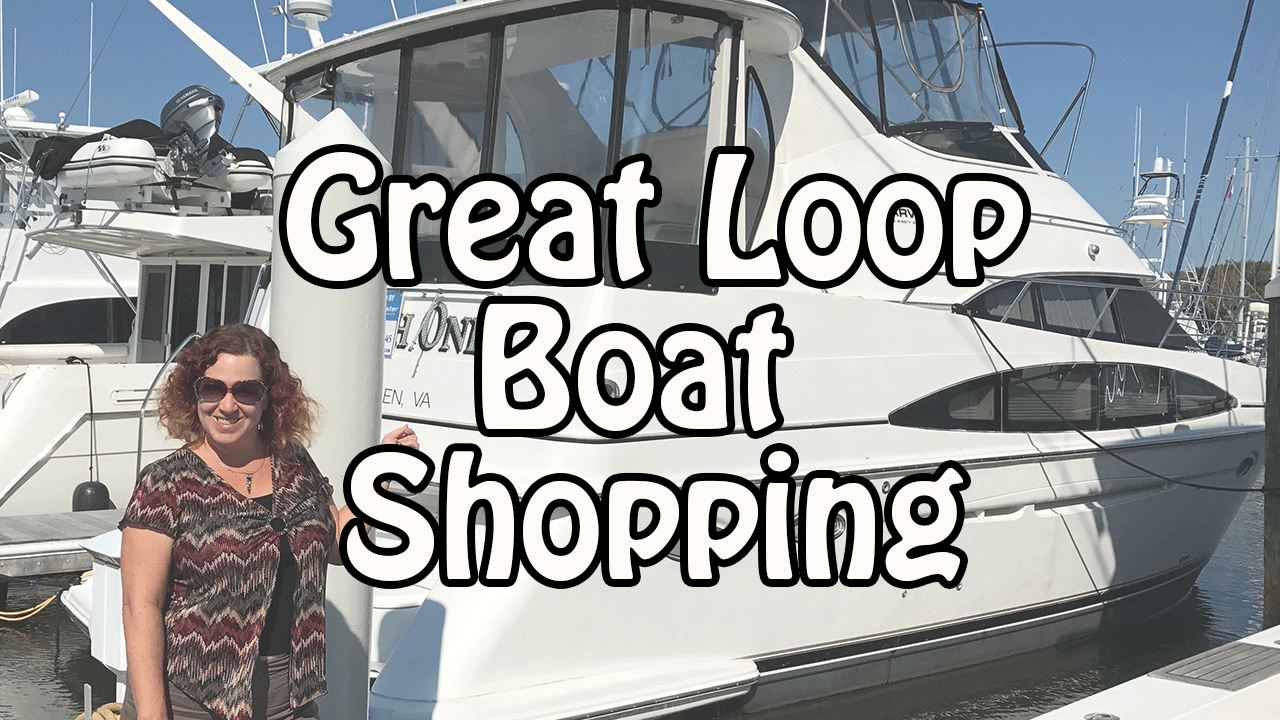
For those who may have missed the post announcing our next adventure – our plan is to soon start dividing our time between life cruising the back-roads of America in our bus Zephyr, and cruising America’s Great Loop in a boat.
But first – we need to find the boat!
This post is the first chronicling our boat hunt.
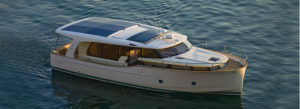
Boats, like RVs, are all about compromise and trade-offs – and the Great Loop in particular adds some hard constraints to the mix.
We’ve spent the past few weeks touring (both physically and virtually) as many boats as we can – trying to get a better handle on what we want in our floating second home.
And with every boat we tour, how we balance the trade-offs seems to shift a bit – sometimes simultaneously broadening and narrowing the focus of our hunt.
Here are some of the big goals and constraints we are weighing – and our current thinking on what we are looking for in our Great Loop dream boat.
First, here’s the quick video update version:
Boat Age, Condition, Cost, and Financing
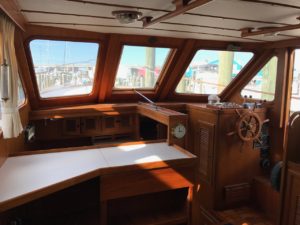
Just like RVing, you can do the Great Loop on just about any budget.
Particularly if you are willing to sacrifice creature comforts, or if you have the time to invest in taking on an old fixer-upper boat from the 70’s or 80’s – almost anyone can afford this adventure.
Plenty of people have done the Loop in boats costing well under $10,000, and the Captain John ‘Frugal Voyager’ website is full of great tips on how to affordably tackle Looping.
But unlike a lot of Loopers – we aren’t taking a year off to do the Loop in one big grand gap-year adventure, nor are we retired and looking to stretch our retirement funds while focused on nothing but boating.
We still have full-time days jobs to focus on, and rather than cranking out the Loop in a year we are intending to move at a slower pace – dividing our time between bus and boat over the next several years, or even longer.
We’ve decided we’d rather spend more up front for something that will be a comfortable home for the duration, and for something that is relatively turn-key and ready to go.
Besides – we’ve already had plenty of adventures with restoring an old classic, or living minimally in super small spaces. We are ready for new and different challenges.
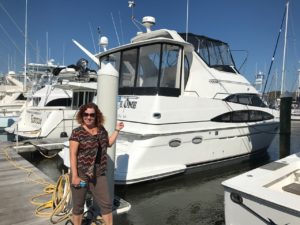
Right now it seems that the sweet spot for us will be finding a boat that is 10-25 years old.
We are open to older boats that have been lovingly restored, maintained, and updated – but we are very wary of taking on something that may have lurking major issues that might need to be immediately dealt with – such as replacing rusted fuel tanks.
The one other catch with older boats we have discovered is that it seems all but impossible to finance boats over 20 years old, ruling out a lot of the best older boats old boats because they are out of our comfortable cash price range.
Although we are completely debt free, and have been for years – we are suprisingly growing more and more comfortable with the idea of a larger / newer boat that we would finance – taking advantage of our excellent credit, current low interest rates, and ongoing mortgage interest deductions. We’d make a sizable downpayment, and then put 3-4 years worth of payments immediately away in a separate account. Financial planning wise, it tickles our brains similarly to our cash budget, but keeps more of our assets liquid while affording us a hopefully better boat.
This opens us up to looking at pricier boats that are potentially 5-15 years old.
But just because we are looking for a turnkey boat, it does not have to be absolutely perfect.
No boat will be.
If there are a just a few key manageable refit projects that can be tackled in just a month or two over the winter before we move in, that might work for us. While a boat by the very definition is going to be an ongoing maintenance project, those that have serious risks of immediately becoming huge projects (such as replacing the fuel tanks, or rebuilding an engine) that delays our adventure right off the bat aren’t in the running.
We love the idea of a recent loop veteran boat that has already been lived aboard, had the bugs shaken out, and which has a known history.
A low-hours boat that has barely been used in its life before us raises red flags.
Boat Type: Sailboat vs Trawler vs Motor Yacht
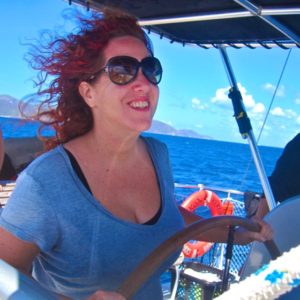
When Cherie and I first dreamed together years ago of future adventures on water – we both imagined that a mast and sails would be essential features on any future boat that we would own.
And while it is possible to do the Great Loop with a sailboat, there are many bridges and inland waterways that make doing any actual sailing along much of the route impossible.
Many Loopers with sailboats actually leave the mast and sails behind, or they ship them from somewhere along the Hudson in New York to meet them in Mobile, Alabama.
Some avid sailors step the mast and lash it to the deck, raising it again to sail the Great Lakes only to drop it again to transit through Chicago and the rivers.
There is one advantage of sailboats on the loop – they tend to be incredibly fuel efficient, even if under motor power 100% of the time. One couple we found did the entire loop in a Gemini Catamaran using only 672 gallons of fuel to cover 5,812 miles!
But for us – a sailboat probably doesn’t make sense.
We know if we had a sailboat we’d want a catamaran large and comfortable enough for living aboard, and spending so much on such a capable sailing vessel only to immediately dismast it seems wrong.
So… That means we are hunting for a motorboat. But what kind?
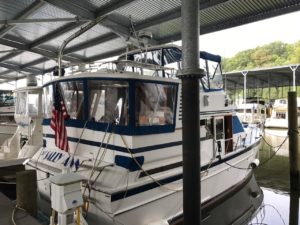
There are few popular types to consider:
- Tugs – There are some adorable miniature tug-style boats that are well suited to the Loop. But they tend to be very expensive, and the ones we have toured have awkward and seemingly uncomfortable interior layouts for full-time living aboard.
- Trawlers – Trawler-style boats (especially those with aft-cabins) tend to have great interior space for living aboard, and are very popular for doing the Loop. Displacement-hull “true” trawlers are designed to travel slowly over great distances, and can be relatively fuel efficient. But many displacement trawlers are typically better outfitted for ocean crossings than inland cruising. More common on the Loop are semi-displacement trawlers that have less efficient hulls, but which can move faster through the water with enough power (and fuel) thrown at pushing the boat.
- Motor Yachts – Our goal in doing the loop is to travel slowly, so we at first dismissed these “go fast” boats with planing hulls designed to get up above the water to move fast – burning gallons of fuel per hour in the process. But as we’ve researched further, more and more Motor Yacht designs have appealed to us. Having speed when you need it can be nice – and when running slowly many people seem to claim that their motor yachts are nearly as fuel efficient as comparably sized semi-displacement trawlers, as long as you can resist the temptation to go faster. Lately we’ve been drawn to “Express Style” Motor Yachts that ditch the flybridge, and are thus better able to fit under bridges.
There are other types of suitable boats too. Hybrids with solar panels and electric thrusters fill us with geek lust, and there are some sweet power catamarans out there too.
And the idea of designing and building a fully custom beauty to meet our exact specifications is the stuff of every mariner’s fantasy.
But when it comes to practical and affordable – for us a relatively mass-produced trawler or motor yacht seems to best fit the bill. There are certainly plenty of viable options on the market that seem like they will fit comfortably into our budget.
The key though for the Loop is finding something that will physically fit.
A Boat Sized for Looping
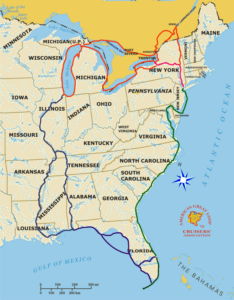
There are certain requirements that every Great Loop boat must meet.
The trickiest one is bridge clearance.
To get from Lake Michigan to the Illinois River, every boat doing the Great Loop must get under a 19′ 6″ clearance fixed bridge on the Calumet Sag Sanitation Canal.
There is no getting around this – and this height limit rules out a lot of boats with elaborate flybridges or a tall superstructure.
But you have to be able to get under even lower fixed bridges if you want to be able to take some of the most enticing Great Loop alternative routes.
For example, to take the scenic cruise along the Chicago River past all the downtown skyscrapers requires getting under a 17′ bridge.
The route north through Lake Champlain to Montreal also requires getting under several 17′ bridges – and we consider this route a “must do” in our personal Loop planning, ruling out a huge number of other boat options.
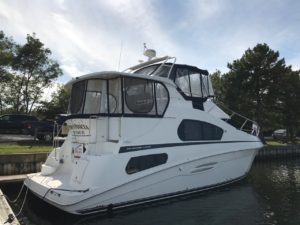
And to do the scenic western Erie Canal between Syracuse and Buffalo requires squeezing under many bridges as low as 15′ 5″, with 15′ as a suggested max height.
To see just how gorgeous the western Erie canal is, and just how low some of the bridges are – check out the awesome recent videos from Shaun & Julia Sailing Around the World – a young couple who have set out to take their tiny sailboat down from Canada to Florida by way of the Erie Canal.
We’d love to keep our options open for exploring this route.
We’ve discovered that while it is easy to find out about bridge heights, it is hard to find accurate information of the bridge clearance attributes for various boats. Some that we had initially ruled out we’ve now discovered can actually fit under certain bridges by lowering antenna masts, folding down hinged radar arches, or dismantling a Bimini shade.
And with many others – these routes and bridges are straight out impossible.
The other major Great Loop constraint is draft.
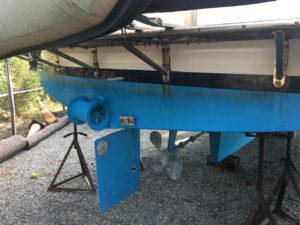
There is a lot of shallow water to contend with along certain sections of the Great Loop, and boats that can handle thin water have a major advantage.
Some of the highlights of the Great Loop are the Canadian historic canals – and these impose a hard limit on boat draft. The Chambly Canal is charted at 6.5′ deep, the Trent-Severn Waterway (one of the highlights of the Loop) is 6′ deep, and the Rideau Waterway from Ottawa to Kingston is just 5′ deep. Boats drawing over 4′ are actually asked to sign a waiver before proceeding!
To keep our options open – we are seeking out a boat that draws 5′ max, though less than 4′ is ideal.
The Canadian canals also have width limits that rule out some large catamarans on these routes – such as a 24′ beam width limit on the Big Chute Marine Railway, or a 21′ width limit on the Chambly canal.
As for length…
If you happen to have a megayacht more than 90′ long, you might have trouble with some of the locks, but odds are likely the other limits will have ruled the Loop out for you already.
Our size goals:
Being able to get under the 17′ bridge for the Lake Champlain route is mandatory for us, and getting as low as 15′ to open up exploration of the full Erie Canal is very appealing – but we are willing to compromise on this if we have to.
As for boat length – 40’ seems to be our sweet spot, +/- 5 feet.
We like that a smaller boat with a smarter layout will be easier to maneuver and much more affordable to operate over time, but we are growing increasingly tempted by larger boats that are overall more livable – indoors and out.
Anything over 50’ though is likely going to feel WAY too big for just the two of us, and not worth the ongoing extra costs.
Interior: Comfortable Salon and 2+ Cabins
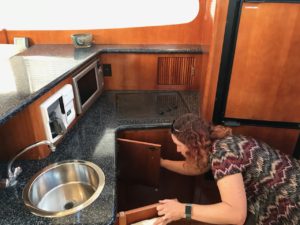
We are looking for a boat that will be at least as comfortable as our bus for living (and working) aboard, and that has been surprisingly hard to find.
A lot of even big boats are set up for holidays – with tiny closets, limited storage, very minimal pantry and fridge space, and ridiculously small galley sinks that could barely handle washing a plate – much less pots and pans.
We want something that is suited for live aboard life, and we are growing less and less inclined to compromise on this.
We want a comfortable interior – with lots of windows and ample views. Dark wood and cramped interior spaces are not appealing to us, and 1980’s color palettes (pinks and pastels, ugh!) turn us off too.
As for cabins – we want an island queen in the master, and we are so far most drawn to aft-cabin layouts that would give us a large full-width bedroom.
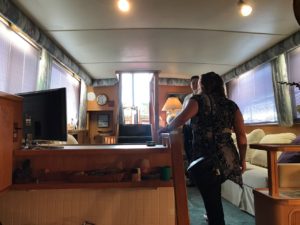
We also want a ”VIP” guest cabin – with space for our parents or another couple to comfortably join us for a week or so at a time. A lot of boats have guest cabins that are more like like caves, and we want to be able to offer our guests better than that.
For privacy reasons, ideally we want the guest cabin to not have an adjoining wall with the master cabin too.
For all these reasons, split front cabin / aft cabin layouts have been most appealing to us.
We are also growing more and more intrigued by having a small third cabin, which we could use for storage, the litter box, tech cabinet, office space, and/or occasional overflow guests.
Our Interior Goals
This is what we are looking for:
- 2 or 3 Staterooms
- Great Windows / Views
- Air Conditioning
- “Practical” Galley
- Large Fridge (bonus points for a residential fridge and/or ice-maker)
- Good place for a litter box
- Ample Storage
- A good work space (with views) for the day time.
- Comfy couch and a place to put a big screen for movie nights!
Outdoors: Sundeck Mandatory!
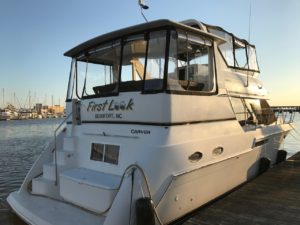
We’ve talked to many Loopers who have told us that the favorite space on their boat is their outdoor shaded sundeck. These covered back porches essentially become an outdoor living room, and we’ve fallen in love with this space on every boat we’ve toured that has one.
A lot of boats however lack a shaded sundeck – focused instead on providing an open cockpit for fishing or soaking up the sun.
We’ll take the shade please! In fact, we consider a proper ‘shadedeck’ mandatory.
Yes – a sundeck instead of a cockpit may make line handling going through locks more difficult, but we’ve had enough people reassure us it really isn’t that big of a deal.
We are also looking for low maintenance when it comes to taking care of the exterior of the boat.
Though all boats require regular ongoing maintenance, a lot of older boats have wooden decks and railings that can look beautiful – but which are a headache to keep that way. We’ve been warned repeatedly that exposed wood can require continuous maintenance – which is not something we are interested in.
And besides – we actually like the look of fiberglass and stainless steel.
Our Outdoor Goals
This is what we are looking for:
- Large shaded sundeck!
- Fiberglass deck – no high-maintenance teak!
- A practical dingy that is relatively easy to deploy and board.
- A place to store bikes and inflatable SUPs.
- And of course, any boat we buys needs to be photogenic…
The Guts: Mechanicals & Systems
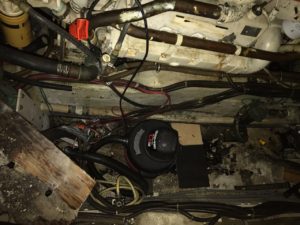
There seems to be religious wars akin to Ford vs Chevy all over the boat forums – with people advocating with fervor for their favorite engines: Cummins, CAT, Volvo, Yanmar, and others.
Even Detroit Diesels (just like in our bus!) are still commonly found powering various boats on our target list.
Though we do already know a thing or two about working on Detroit 8V71s, – we really do not (yet) have any favorite “must get” engine.
We just want something fuel efficient, quiet, easy to work on, and that will be overall reliable.
Our Tech Goals
This is what we are looking for:
- Twin diesel engines, or single plus a bow thruster. Maneuverability, ease of docking, fuel efficiency, and reliability are MUCH more interesting than speed to us.
- Fuel tanks enabling 300+ mile range, and 500 miles is even better.
- Autopilot.
- Quiet generator.
- Workable engine room.
- Geeky modern marine electronics – if they aren’t there, we’ll eventually add them ourselves.
- Space for eventual lithium and solar upgrades, of course…
One worry – it seems that engines that are built to go fast may not like to go slow. So even if they can travel slowly with minimal fuel burn, our desired pace might not be good for these turbo-charged engines in the long run.
If we end up with a “go fast” boat – learning how to best take care of the engine when doing extended periods in no-wake canal zones may be a challenge.
Boats On Our Hit List
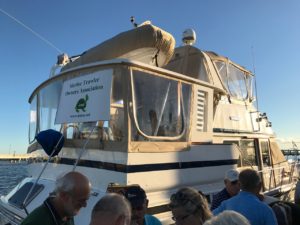
Here’s a look at two of the boat types we’ve toured so far – showing the wide range of options that are still under consideration:
- “Taiwanese Trawlers” – Our first online boat crush was the Jefferson 42 – a classic live aboard trawler design that was replicated by many Taiwanese boat builders in the 80’s. But many of these boats built in the 1980’s have issues if they have not been well cared for, and finding one that has been suitably updated will be a challenge. Bridge clearance is also a potential issue for some of the routes we want to explore. Aside from the Jefferson 42, we have toured a few other similar aft-cabin trawler-style motor yachts from the 1980’s, including a Marine Trader 40 and a Chris Craft Catalina 427. There were things we liked about each of them – but the age and condition of some of the boats of this era did raise red flags for us.
- Carver 396 Motor Yacht – We fell in love with this boat online, but initially ruled it out because the official 18′ clearance would not be able to do Lake Champlain. But when we stumbled across the Evening Star blog, we learned that the Carver 396 actually could do this route with only a few minor modifications! We really loved the way the interior of this boat felt – the windows and natural light were fabulous, and the large salon and modern styling were great. But once we got on board, we didn’t like that the kitchen felt more designed for a weekend than living aboard – with a tiny sink and very little pantry space. And the bedrooms (particularly the front) were lacking storage space too. The sundeck area was also smaller than other boats we’ve loved. This boat remains on our list, and it has turned us on to more modern styles. We also toured a slightly older Carver 406 that wasn’t as sleek and stylish as the Carver 396, but it had a more practical setup for living aboard – with more storage, a better kitchen, and a much larger sundeck.
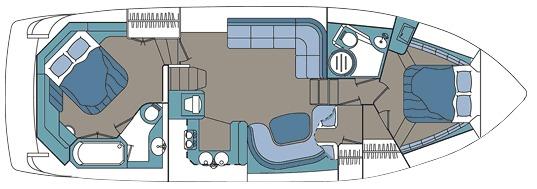
Our current online boat crush is the Cruisers Express Motor Yacht – either the three-cabin 455 or 4450, or the smaller 405 or 415.
This unique style of boat seems to offer the liveaboard interior space of a motor yacht, but by trimming away the flybridge and placing the helm on a lower level it means that this style can fit under bridges with ease too.
It’ll be the next style of boat we line up to see (soon, hopefully!).
Dream To Reality
A lot of people spend a long time hunting their perfect boat – they’re planning their boat adventures years off into the future.
Not us.
We are ready to get on the water – even if that means making a few compromises along the way. We are actively working with a buyer’s broker to more efficiently guide us through this process.
We want to have the boat ”ready to go” by Spring 2017 – allowing ample time for getting comfortable with it, getting training and shaking out any issues. We are theoretically open to starting anywhere along the Great Loop, but a boat currently located anywhere in Florida or as far north as the Chesapeake would be most ideal.
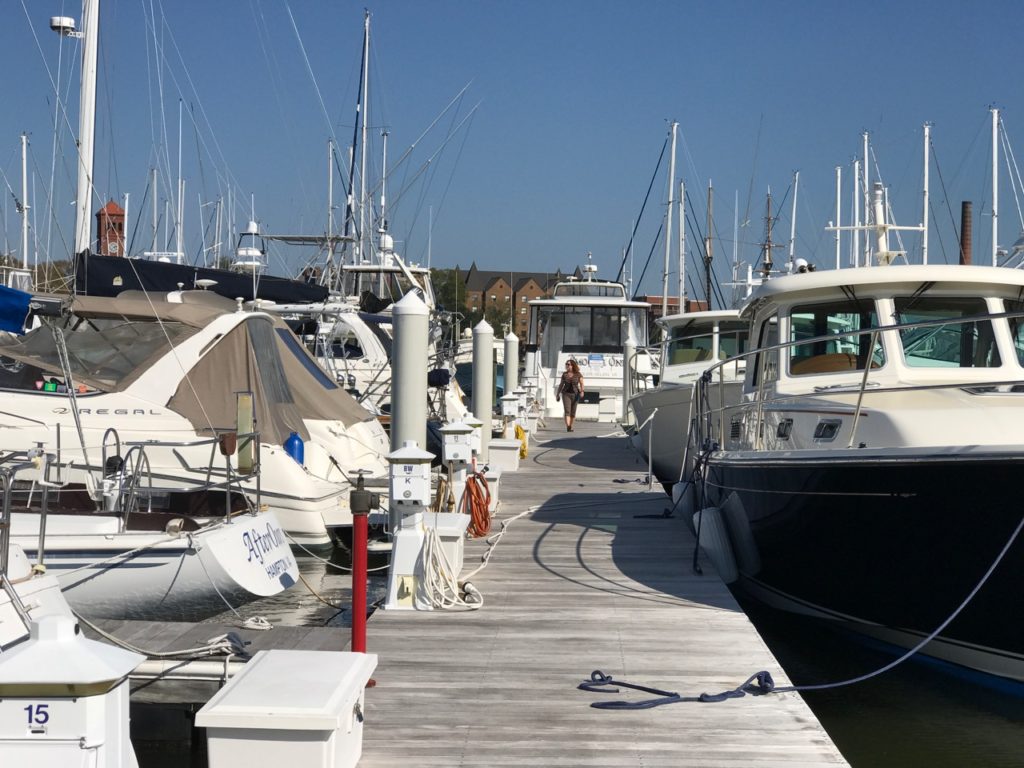
Suggestions? Leads?
Constructive feedback and suggestions on our wish list, and tips on boat brands and models to check out is appreciated – especially if you can point us to options that are actually currently for sale.
Do you have a boat for sale that you think meets our criteria? For sure – be in touch!
But remember that there is no one right way to do the Loop, and no one perfect boat for everyone. Our personal dream boat may not be yours
If you are interested in following along in our hunt – we are happy to share the adventure!

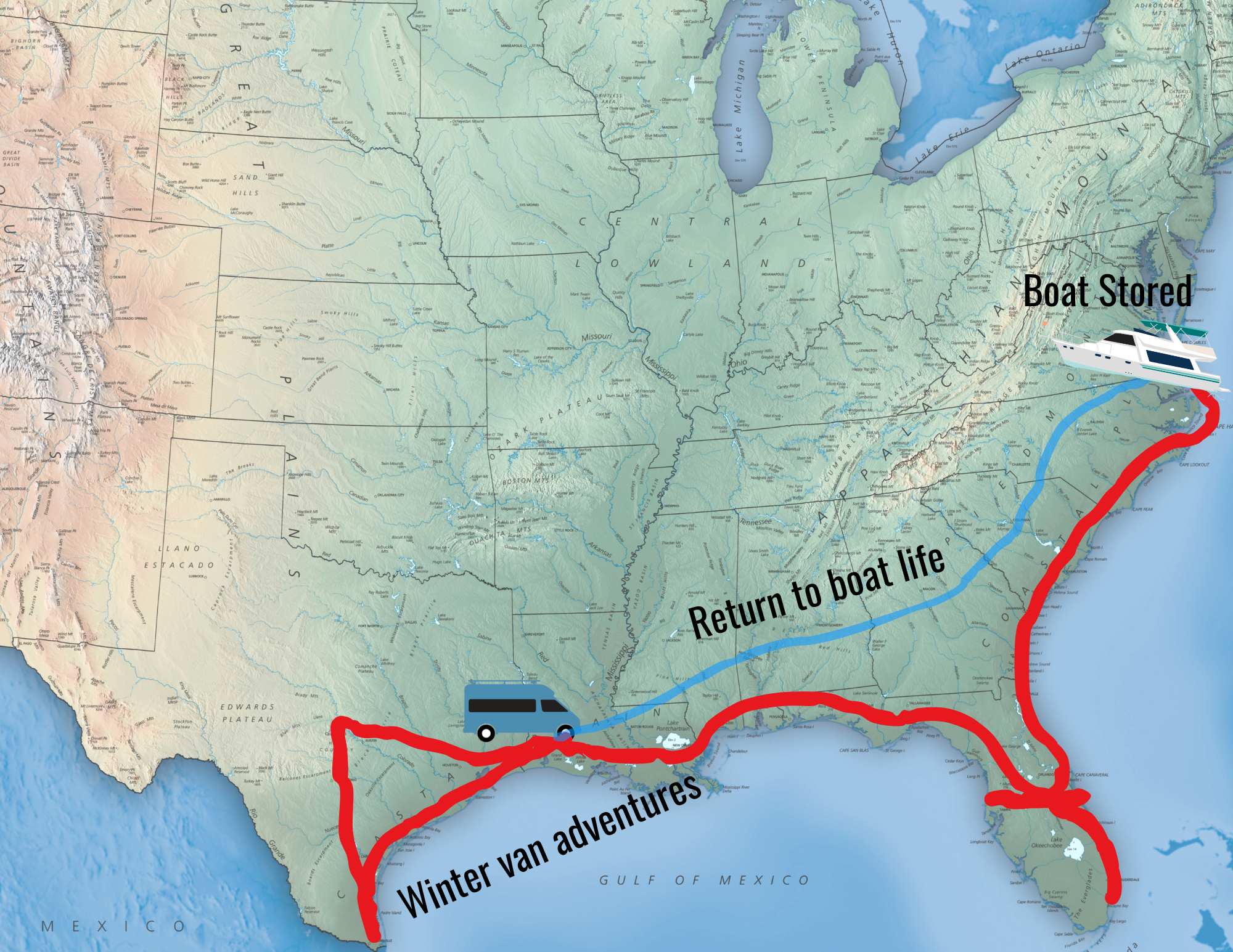
I have a 1999 Carver 356 and have done the complete Erie Canal. I just put thr radar dome on a hinge and removed the anchor light and laid it on the hardtop? Three screws.
POP Yachts has included the ability to search its classifieds section for “Loop vessels”:
https://www.popyachts.com/great_loop-boats-for-sale
These boats simply meet the beam, draft and bridge clearance requirements for the typical loop.
Don’t leave port without it!
http://www.skipperbob.net/publications
Marine Trader 44
Dutch Star 38
Hello again! After reading your last blog about the boat search, it seems your leaning toward a slightly used boat. Considering the time you may take to upgrade, about what time of the year and season you hope to start the Great Loop? and for the sake of meeting you two, where would you be starting?
The Julys
So much will depend upon where and when we find the boat. Gotta get there first.
Gotta get there first.
We are taking all of 2017 to finish our houseboat and bus. However, to let you know that my wife and I are taking in all that the two of you are going through and really appreciate your sharing! We expect that in the next two to four weeks you will be down to a few final selections. Sorry you didn’t find a great deal in S.C. . Keep up the good search and reports!
Marvin and Collette
There were likely several good deals to be had in SC, but that’s not really the phase we’re in yet. Still learning & researching
Most boats are OK on good days. It is when you get caught out on a bad one that counts. We cruse the AICW and have had some very bad ones. Sea worthy is paramount and crew safety.
A lot of newer aft cabins the crew can not safely work lines, fenders and anchor on a good day never mind when the boat is getting rolled and pitched.
Remember you top 10 bad rv list. It is the same for boats.
But it is well worth the experience.
IMHO Florida is probably one of the best area to search for a cruiser.
Do It!
The Carver 396 is also one we looked at. If you can find one with diesels that’s always a plus. We liked the Merdian’s as well, check out the 341 and 368.
I’d probably end up with a trawler though, while smaller inside the Grand Banks 36 was copied by just about everybody, can be gotten fairly cheap, and has great GPH fuel burn.
My wife and I smiled when we read this because we’ve been going through the same discussion/investigation over the past 18 months and have landed in precisely the same place as to requirements. We’re currently at the Ft. Lauderdale boat show to confirm for one last time that boats no longer on our short list do not deserve a reprieve. Current finalists are the Sea Ray 480 Motoryacht (2002-2005) and the Endeavour TrawlerCat 44 (2002+). We’ll pull the trigger before yearend.
Hi. Great post!!! You really got my husband and I talking again about the Loop and a boat. Ha – you kept us up late talking and talking (and wine-ing and whining). Love the idea of doing the Loop part time over several years. We debated before buying our mh this past January, but with family obligations the land yacht is the best course for now. A PDQ catamaran from ~2000-2003 was what we were considering (i.e. dreaming about). Wonder about the beam though and the locks. Well, thanks for getting us fired up. We will be watching what you do closely. Soon as we could do it is about 2019 so we can learn from your adventures. Thanks for all you share! Susan and John
Susan and John
I’ve heard from many that the PDQ PowerCats are fabulous Loop boats. The small cabins rule them out from what we are looking for, but if you are OK with the trade-offs they have a lot of great advantages too.
Yeah know what you mean, but your idea of looping part time mixed with other forms of travel living got us jazzed again. Makes the size not as onerous. John is partial to the way cats handle as he had a sailing Prout a number of years ago. However until a decision is made we are open. Will be glued to your posts as you make your decisions!
There are many good suggestions below about different boats and the pros and cons that will fit your needs, now the problem is to develop a list of your – basic boat needs/requirements; must have accessories/amenities; would like to have. It sounds silly but I think it is a must as you look at such a variety of boats. We developed our list as we became liveaboards and it really helps. Some things that we thought we just had to have moved to the wish list as other items moved to the top of the list. Through the process our main lists became smaller as we realized what was really important to both of us.
Among some other thoughts to consider. If possible I would go for a diesel engine for a couple of reasons. They are easier to maintain, especially if you are leaving them for extended periods of time (gasoline turns to varnish in the carbs if left for too long). Primary concerns for diesel is clean fuel and oil changes, no tune-ups. They can also be more economical.
Single engine versus dual engines. Yes, you can go faster with two and you can then consider a planing/semi-planing hull, and you do have a back-up engine if something happens to one. Regarding a back-up engine note above, diesel’s are more dependable therefore with the proper maintenance/fuel this is less of an issue. Second, you may need to go faster because of the weather or to get places!!!. The difference with cruising is that you are/should be looking at the weather every day you are moving so that should not be an issue. And, you are thinking of taking your time and enjoying yourself which usually happens at a slower pace. Another reason is that on the Mississippi there are some long distances between fuel stops and you need fuel efficiency or large tanks and extra storage. Maneuverability is helped with thrusters for tight spaces.
There are some good older boats but make sure you have it surveyed, a surveyor is trained to find issues. The extra cost for another pair of eyes to look over a boat is worth it when compared to the price and potential cost of repairs. Having said that there are a few books by Don Casey you should have in your library that prepares you to do your own pre-survey inspections, worth the cost. A northern fresh water boat is usually in better shape, used for half the time and less saltwater and UV degradation.
Size. While bigger does provide you with more livable room, there will be areas that you will have difficulty in finding slips/moorings or even enough anchoring room. On Lake Champlain there are very few marinas that can provide dock space for any vessel as it approaches 50′. Then add in the costs.
I traveled Chamby Canal many times in a 72′ with 25′ height with no problem but the Champlain Canal should be below 15′. If lowering a radar tower gets you below this then just leave it down when transiting the canals as you really don’t need it, if it is so foggy you think you do, maybe you should not be moving, you are not on a delivery schedule.
The Erie Canal is great! Perhaps Lake Champlain, Chanby Canal with visits to Old Montreal and Quebec City should be one of your side trips. Lake Champlain is 120 miles long with lots of history and great towns and anchorages to visit. And Old Montreal and Old Quebec City are great places to visit when you are in a slip right downtown.
Just some thoughts, have a great time.
Thanks.. this post is our evolving list And many of the points you mention were covered in it.
And many of the points you mention were covered in it.
Wow, sounds like a grand adventure. I’d never heard of the “loop” before. I can’t wait to follow your boating adventures too! Good luck on your search!!
What a great post Chris. I am not a boater, but found your search fascinating. Great job giving lots of details and keeping it interesting for those of us who aren’t boat people!
If you set a goal of $100,000 you could do really good boats under that
On a defever don’t let the age fool you but I would go fiberglass and shy away from wood
If you buy one on the West Coast it’s not unusual to do passage through the Panama Canal to the East Coast if you do the research you will find that a lot of them do that East To West Or west to east
Depending on the style of the coach top(bridge) it can be lowered and truck Most anywhere I’ve done 2 One to Florida and one to San Diego
They even have their own defever club
There’s one in here that even has new tanks
http://www.boattrader.com/browse/make/defever/Page-1/ViewType-photo/SortBy-year.desc/PerPage-20
I had no idea there was so much involved in choosing a boat, and you’ve learned fast in order to write such a detailed post. Don’t comment much, but really enjoy your blog. Bought a little R, ourselves this fall, and hoping to do some long trips out west. Have to sort out the easiest way to have internet with us, so I’ll be hecking your resources.
I love this !!! I got my 4106 after reading your blog. This loop looks really cool, I am excited to see how you guys do with this it looks really exciting
First off, thanks for sharing your wisdom gained via experience with the rest of us! I first came across the “RV Rental” archived chat a few weeks ago and have been devouring your back (& more current) content since.
The research & feeling-out process you all are going through with the boat oh-so-closely parallels where we are with investigating RVs. The competing considerations, the figuring out where compromises can get made, what’s a deal-breaker…
Unfortunately, all I can contribute re boats specifically is to concur with the “you don’t want to mess with exposed wood” admonition. Family experience talking here.
We had no trouble financing our 1979 Defever trawler through our credit union.
That is good to know – we’ve had several people tell us that it was essentially impossible to finance older boats. But maybe it isn’t quiet so hard – at least for a known brand with such a good reputation.
We once took a canoe through a lock on the Mississippi in St Paul, MN. You don’t need as much room on your boat as you might think.
We used to live in a 16′ clamshell travel trailer – and we did great in such a small space. We know we can do it small – but for this next adventure we are intentionally looking for a boat that will give us more space to stretch out.
Diesel, unless you find something with outboards (doubtful given your criteria, but here in NC they’re being used on larger and larger boats).
I’d encourage you to hold out (and pay up?) for the brand that will make resale easier 4-5 years down the line. You know the type from RVing. The brands whose reputation leads to multiple offers and often a sale even before being publicly advertised. NordicTug comes to mind, but I’m sure there are others.
In other words, buy with a strong eye on a potential sale once the adventure is over. It’s easy to make a compromise now that you’ll regret later (think $5 fuel prices and the used boat market).
Wow – what a post! Lots of information there and it looks like you have really thought through what you are looking for and how you plan to go about getting the boat. Fun to read about and see how you are approaching this. I like the ‘best of both worlds’ where you get to RV and embark on your boat adventures. Good luck and thanks for putting it all out there for us to enjoy and follow along!
Wishing you luck with your hunt for the right boat. Hopefully it won’t get to stressful. Looking forward to your journey on water.
We have a 49ft (45ft with 4 ft cockpit) Taiwanese built Aquarius aft cabin. We spend 90% of our time on the aft deck. We had a boat with a lower station and never used it. We do love the cockpit as it makes docking, fishing and sometimes boarding much easier. Jefferson, Defever, Hatteras, Heritage East are some names to check out. For more modern looks Sea Ray, Cruisers, Silverton and Meridian to name a few. They all make aft cabin floorplans. Our motorhome has a Cummins and the boat twin Cats and we love them both. So many choices, so little time. Have fun shopping and we look forward to hearing more about your adventure.
Great article and I am at the early stages.
You mention cats that sail but what happened to power cats? http://www.yachtworld.com/boats/2001/Pdq-MV-32-3008248/BRADENTON/FL/United-States#.WBNA6MmHMo0
Another interesting boat and very capable but VERY limited production is the Stolkraft https://www.facebook.com/180046148713372/photos/a.349681185083200.104418.180046148713372/1031605616890750/?type=3&theater
this is the boat I will be going for.
Power cats were mentioned in the article
Good luck in your hunt.
No useful suggestions from me except cooool! So much fun reading about all this new stuff.
Nina
Great Blog, we have the Cruisers Yacht 375
It feels like a 40 footer and wouldn’t trade it for the world. Bought it in Florida and brought it to Canada where we cruise the Trenton Severn. I especially like the flybridge and upper deck.
Good luck in your search.
Regards
Michael
All of this sounds so great, and such a new journey… we are just getting ready to hit the road…now I want a boat instead! You two will figure it all out, and we get to have the luxury of observation. Good luck Chris and Cherie… you two are inspiring.
Laura
So good for you guys getting into boating! We have been coastal cruising and boating since the mid 70’s and still live aboard summers in RI. We are former sailors and currently have a Chris Craft 350, solid boat, solid glass hull and has the accommodation of a 40 footer, but even so has become a bit too small for us at this point – and the gas engines were a big mistake. We are lucky to have cheap dockage in a beautiful spot. Like you said everything is a compromise and everyone has their own opinion and what works for them. We are still looking too. We would not go bigger than 45 or handling, dock fees, availability of suitable moorings and the like start to get out of hand. I think you are spot on in regard to most of your assessment for the trip you have planned. Not a catamaran fan, the ones I know have choppy interiors, are too wide to dock at a lot of marinas and are noisy as heck when running the engines. Our boat of choice would also be an aft cabin layout. If you haven’t already you might want to look at boats like the Mainship 43 or Saberline 43. The Albin 43 is also solid and seaworthy and tends to ride dry. Just some designs we know and tend to favor. These all have the the trawler look and seaworthy attributes but a semi-displacement hull – they will have very high fuel burn at higher speeds. Boats like the Carver with a planing hull should be more fuel efficient at speed. If slow and efficient were your goal something like the raised pilothouse Kady Krogen 42 would be a contender. The Hatteras LRC was one heck of an awesome boat with ocean crossing capability but a true displacement hull and very slow – and they go for big bucks considering they are 70’s vintage.The Mainship 40 is a nice newer design with a fabulous upper deck and real stairs (cat friendly) but my guess is too small for your needs. We recently looked at a Navigator 44 that had great accommodation and nice, quiet, efficient Volvo’s – liked a lot about that boat but would still prefer the deep protected walkarounds for line handling on the trawler designs. You are most correct that exterior wood is a major hassle. Make sure whatever you get has good ground tackle and a windlass. Agree with previous comments about a single screw with a protected keel minimizing prop fouling, but two engines give you redundancy as well as easy handling. Compromises. Beware of southern boats, unless stored in covered docks they tend to get the crap beat out of them from the sun and often never come out of the water. We looked at several and there was a lot more deck deterioration, interior mold, saturated hull cores and blistering than you find with northern boats that spend half the year out of the water and covered up. Could go on for hours, if you ever want to discuss further get in touch. Good luck!
I know nothing about boats except that the water goes on the bottom – but I’m already enjoying this grand adventure of yours!! Per usual you’re doing lots of good research and homework, I’m sure it will lead to your perfect boat.
Your journey sounds great. Used to dream about a voyage such as you envision. Great your starting early enough in life. We’re happy to be able to continue are long timing Rving as long as possible. I didn’t see any mention of it, but it sounds like a power catamaran would be ideal. I’ve been partial to multihulls for there many benefits for more than 20 years. On third one now.
We actually mentioned power cats in the above post.. but they seem to be above our price range.
I’d love to tour a few power cat options – and they do have a lot of raw potential.
The biggest downside I see with power cats is that the cabins in the hulls tend to be rather small, and there aren’t a lot of used ones on the market that are affordable.
But if you have any leads on brands or boats we should check out, let us know!
PDQ 34:
http://www.yachtworld.com/boats/2004/Pdq-PDQ-34-2803881/Canada#.WBYG2tyX6dx
no affiliation, just a fan of the boat for Great Loop cruising.
The PDQ 34 is an awesome boat for cruising the Loop, but it is not a great boat for long-term living aboard. In particular the two cabins are really tiny, and require climbing over each other to get into bed.
We are looking for something a bit larger and more comfortable – our goal is something at least as spacious and comfortable as our bus.
Don’t do gas,,,diesel,,on the way to go
Just remember travel lift if you ever need it charges you by the Foot
Storage yard also charge by the foot and you may or may not be able to work winter rise by sunrise on your own boat in that yard
If you buy it on the West Coast and have it shipped to the East Coast be concerned about your size as well as the recitation of the shipper
One other consideration On Google go to the Netherlands and France Holland Germany and look at canal barges If you haven’t looked at that option maybe you surprised
If that would fit your option you may want to check and find out what it would cost to have it shipped to the US one may come out better if that is an option
Also some sailboats come with what they call a tabernacle mast
If whatever type of vessel you wish to buy a must is a marine surveyor as well as past surveys that were ever done on that vessel A good survey is well worth the money you pay them
Definitely pick odysseys brain as well
We’ve definitely been picking Sean’s brain on this And we’ll definitely be going diesel.
And we’ll definitely be going diesel.
In general when I’ve seen boats in Europe come up for sale on Yachtworld, they are a lot more expensive than US options – and that is not even factoring in the time or expense of shipping. So I don’t think that is an option – but I am open to being shown otherwise.
I just checked out the tabernacle mast – so cool! But – I don’t think that sort of easy to self-step mast exists for boats the size that we would want to live on. If we were doing this the minimalist way, that would rock though!
Fascinating all the things you must consider before buying this boat. Did you know a lot of this from reading or from talking to people at shows etc?
I wonder if flying is in your future
Chris has been a licensed single engine pilot since he was 18, and we used to RV with a powered paraglider .. flying is already a part of our story
We’ve been soaking up wisdom from a variety of place – online, people we’ve met, seminars we’ve attended and boats we’ve toured.
If only a flying boat were a viable option… But I’ll just have to keep dreaming about airships for now. *grin*
Delighted to read this, and see the process unfold. As it happens, Ann and I are now seriously looking at sailboats for our dream to seasonally cruise and live-aboard. Wish us luck, as we do you!
Can’t wait to connect up soon and compare dream notes!
I wonder how much dredging it would take to make your dock workable for two boats a bit larger than your current one…
What are your thoughts regarding a lower helm in addition to the one on a flybridge?
Most folks we’ve talked to who have them, report that they hardly ever use them and they’re mostly taking up living space. So thus, it’s not a high priority for us.
If you need to be able to cruise in all sorts of weather, it probably makes sense to have an indoor and an outdoor helm.
But so far everyone we have talked to seems to have one favorite (either upper or lower) that they use 95% of the time, and the other just ends up wasted.
But we are certainly open to hearing more voices with experience chiming in on this issue.
We have been boat searching (mostly online) and the choices are endless, but about all require, as you say, some compromises. I have particularly liked the layouts on the Cruiser boats — and for us, the 3575 us a beauty – we think. Will be interested in hearing about the one you are interested in. My husband is 6’3″, which rules out a lot of boats for us!
Living in a bus with ceilings just over 6′ has made me very appreciative of being only 5′ 11″.
A lot of mobile homes (both on land and water) are just not well suited to those much taller than 6′. The original Technomad Steve Roberts has struggled with the downsides of his height for years.
We’ll check out a video tour of a Cruisers 3575. I am very eager to tour any sized Cruisers boat in person.
Great info! We are just beginning road tripping with a 1983 Blue Bird, but we are going to try to take our horses with us. We want to ride way back in the Tetons, Rockies and BC. But thanks for giving us another adventure, we are 60 and will have to give up our ponies some day…. Hope you have a pleasant journey.
What about this one on Lake Travis… http://austin.craigslist.org/boa/5835805731.html
We have been scouting out one like that to look at. Lake Travis would be difficult to get it on the Loop however
do you have any idea mpg you can get at slow speeds, love the boat
Boats seem to have a huge range when it comes to fuel economy. Some seem to manage less than 1/2 MPG, and others claim as much as 4MPG. Sailboats (under motor power) can do a lot better.
I’d love to hear some owner reports of what real-world Cruisers 455 fuel economy is like.
Oh my! I can see that finding the right boat will be harder than finding the right RV. Good luck with the hunt!
Each one of our three RVs found us when the time was right – and things just clicked into place. We are hoping that the same serendipitous magic will follow us out to sea.
As a former boat nut who was looking at doing the loop, I applaud your thinking. I’d like to add a couple thoughts. On the big rivers, there is a lot of debris in the water. Twin engine rudders and props can easily be damaged. A single engine boat will often have a full keel to protect the running gear. Most single engine boats your size will have a bow thruster. When considering manuvering in wind and current, I recommend at least a bow thruster. On a single engine boat, I’d recommend both bow and stern thrusters. A stern thruster can actually be added to the exterior of the transom. Second point – on the Mississippi River fuel stations are few and far apart. I’d suggest checking this out. I don’t remember but 300 miles range may be cutting it close. Also while you are at Key West a trip to the Dry Tortugas is a must. 300 mile range for that trip is an absolute minimum. Third – electronic high pressure enjected engines can idle much longer then mechanical injected engines like your Detroit diesel.
I wish I was going with you. Have fun!
There are indeed advantages and downsides to both single and dual engine configurations – and the protection of a keel is one of the advantages of going with a single.
But for whatever reason – single engine options that meet even our general requirements seem to be very hard to find. Do you have any suggestions on single engine boats we should check out? It seems that almost everything is dual-engine only now.
As for range – the longest segment between fuel stops on the loop is 260 miles. A boat that can comfortably do 300 miles should be fine, but I’d certainly prefer something that can do 500.
I’m also a fan of singles. First of all, as you say, the running gear is often much more protected. With twins it’s often “hanging out in the breeze.” Also, for a given boat (unless it’s truly large, say 60′ or so), twins will result in a much more cramped engine room, and each engine will have a “dark side of the moon” that’s hard to get to for maintenance. That can make it more costly, and/or certain things may have been neglected (because hard to see, much less access). And of course service costs more on two engines. I’ve also noticed a tendency (not in everyone of course) for a slight “relaxation” on maintenance with twins (again, not all boaters do this). Maybe this is because “well, I have a fallback engine,” or because it’s more expensive to service them, or etc. With a single, owners more often treat them like royalty.
When getting into sea trials, I like to be sure the engine can meet WOT (wide-open throttle) recommendation. Since boats don’t have gears in the way a car does (to upshift), they will be lugging (at all speeds) if they don’t meet the wide-open throttle RPM. I’d like to know a boat hasn’t been run this way for many hours, plus of course have it correctly propped for your ownership (adjusting the prop is how you change the WOT RPM).
Amongst the other nine million things to check, I’d pay close attention to things like seacocks. Sure, one can sink “at sea,” but it’s amazing how many boats sink at the dock due to inadequate or failed hoses/seacocks/stuffing boxes, etc.
So as not to end on a negative note, I’ll say that you’re embarking on an exciting adventure! I came from boating to RV-ing. Now, funny enough, I had just been thinking about perhaps starting the great loop next spring (former sailor but now have small powerboat). I’m thinking about how and where to store my RV, so I’ll be interested to see what you work out on that front. If it’s not someplace safe and easy on the rig (not damp, too hot, etc.) — so that I’m reasonably confident it will be nice to come back to, I know I won’t enjoy myself out on the boat. Would still have to decide between a continuous loop vs. boat in summer/RV in winter (like you, I love desert boondocking).
Anyway, great stuff and glad you are keeping us (your readers) in the loop
Great advice – thanks.
I wonder why it is that single engine options are so hard to find? Almost every boat we track down online seems to to only be available with twin engines.
But we will certainly keep our eyes out!